When teaching 3 digit subtraction regrouping strategies, the standard algorithm has been the go to way since subtraction was invented, right? If you grew up in America and were a child of the 80s like me, you might think so. I can’t recall being taught the alternatives. In fact, this subtraction strategy is known as the “American way”! There are many ways to teach 3 digit subtraction with regrouping (and some of them don’t even rely on traditional regrouping). I love teaching these alternative methods because they allow for flexible thinking, make students consider the value of the ENTIRE number and are, in my opinion, easier!
I would like to show you a few of my favorite 3 digit subtraction with regrouping strategies! They changed the way I looked at math and increased the enjoyment I get out of teaching and doing math. I hope they can do the same for you and your students!
3 Digit Regrouping Strategy #1: The Standard Algorithm
I am going to start with ol’ reliable. She may not be the easiest (or prettiest) car to drive, but you know that in a pinch, she will get you where you need to go! That’s how I feel about the standard algorithm. It has a number of pitfalls that I will get into, but first let’s take a look at this 3 digit subtraction with regrouping anchor chart:
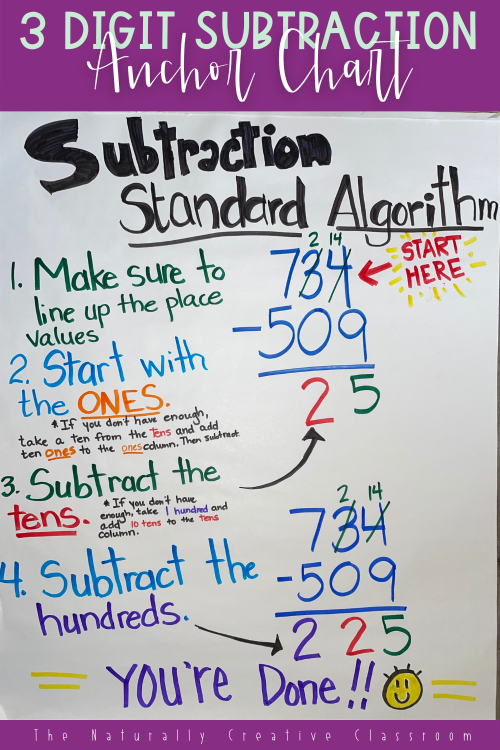
Pros and Cons
Let me start with some of the issues that I have had over the years teaching the standard algorithm to students. First, a lot of kids like to start in the hundreds column. That’s why, on my poster, I have a big “START HERE” to remind them to go to the ones column first.
Once they have that down, many budding mathematicians see no problem subtracting whatever numbers “work”. For example, the problem is 734-509. The students will often subtract 9-4 instead of adding more ones. Ironically, in this problem, you would get the same number.
Moving from the concrete blocks to the standard algorithm is TOUGH. Students need to start to be able to understand that the number in the tens place in 734 stands for 3 TENS and that you can take a ten stick and turn it into ten ones. Even though we do lots of practice with this, many students take awhile to grasp this. That is why it is important to always have manipulatives handy for anyone who needs to see it.
Another issue with the this 3 digit subtraction regrouping strategy is that, no matter what, it is difficult to think of the actual size of the entire number as we are tempted to say “7-5=2” for the hundreds column, when in fact, it should be 7 hundreds -5 hundreds is 2 hundreds. Lastly, have you ever TRIED doing a 3 digit standard algorithm in your head? It’s a jumbled mess for me!
This method is efficient, and as a parent you can easily help your student complete this method, but it is not my favorite tool in the tool box.
3 digit regrouping strategy #2: The Visual Model
The visual model of subtraction is the next step for students who are past learning how to do 3 digit subtraction with regrouping using base 10 blocks and are ready to move onto drawing a representation of the blocks. It is great for very visual students who need to “see” subtraction in action. Here is my visual model subtraction strategies poster:
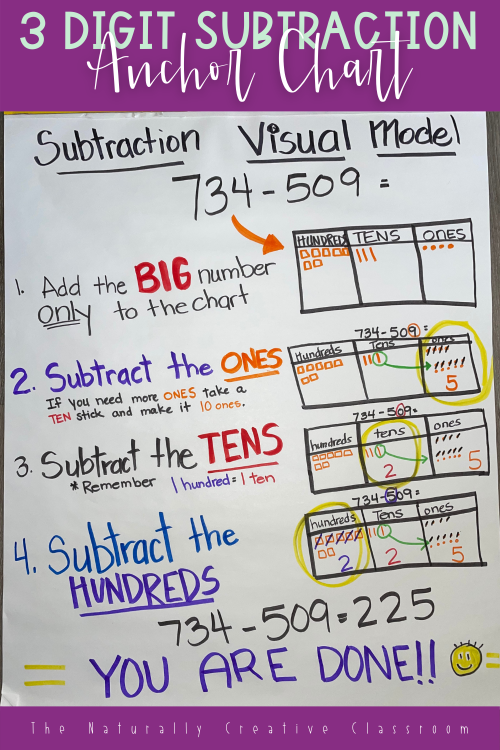
Pros and Cons
When teaching this strategy, you need to be very intentional about how you want your students to set up and draw the pieces, as this can get messy FAST. First, I tell my students to draw all the pieces neatly and in straight rows of 5. Counting them in neat rows is much easier than counting a scatterplot. With this method, it is again critical that they start with the ones.
Students often get confused about which number to put on the chart. This requires a little critical thinking when they are done and end up with the first number of the problem. This is a good point to remind them that they should always think about if their answer makes sense. If something seems wrong, it probably is.
Students also need to be mindful of being sure to cross out what they have used, especially if the piece was “traded” for a smaller place value. It is very easy to forget to circle that tens stick you broke down into 10 ones. This method is slow and requires either a whiteboard to be handy, or lots of paper if you would like the students to turn in their work.
As I said, it is great for very visual students or for students who need a little more support when learning how to subtract. It is accurate, but has a lot of “moving pieces” to keep track of.
3 Digit Subtraction Regrouping strategy #3: The break apart way
With the Break Apart way, we are starting to get into how to teach subtraction regrouping strategies that lend themselves to mental math. The first method I’m going to explain is the Break Apart method. Take a look at this subtraction strategies poster:
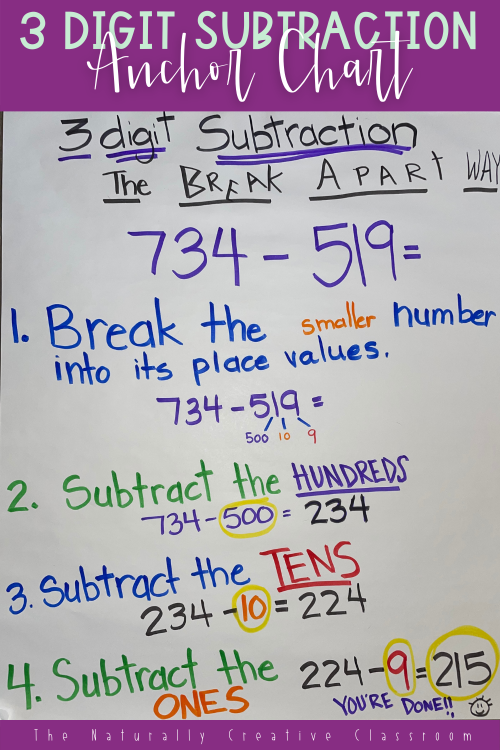
Pros and Cons
One awesome aspect of teaching subtraction strategies that are non-standard is that they are much more flexible than standard algorithms. My brain does a little happy dance. What I absolutely LOVE about this method is that there isn’t any regrouping, or carrying, or rules about where to start! First, students are going to want to break the smaller number down into its place values. This is where all that work with subtraction strategies for 1st grade and subtraction strategies for 2nd grade come in handy! Students should be comfortable working with number bonds and expanded notation.
Next, they are going to start with the biggest number. At this point, they can then subtract how they like. In the example, I took away the 5 hundreds first, but I could have subtracted 4 ones and gotten to the friendly number of 730 and worked from there. If a student chooses to do that, it’s a little more work keeping track, which I will show in the next method. Anyway, it is fairly simple to do 734-500 mentally.
Once I got to 234, now students can subtract the tens, which here is 10, so again, simple to subtract mentally, 224. Last, they will take away the remaining 9. (they WILL work from hundreds to ones)
Of course, students COULD start with the ones place, but I find it easiest to take away the biggest place values first for the sake of mental math. This subtraction strategy allows for flexible thinking and attention to the value of each number in the problem. Cons? It might take parents a minute or two to learn
3 digit subtraction regrouping strategy #4: The arrow way
Ladies and gentlemen, boys and girls, children of all ages, I would like to introduce to you one of our STAR performers! Let’s give a warm welcome to…..THE ARROW WAY!!! (roaring crowds). This is truly one of my favorite ways, but admittedly, it did take me a little bit of study to really grasp it. Once I got it, the artsy side of my brain loved the way it was set up, and that can make or break it for a student. It doesn’t “read” like a traditional math problem. Don’t be afraid, it won’t bite! Here is my poster:
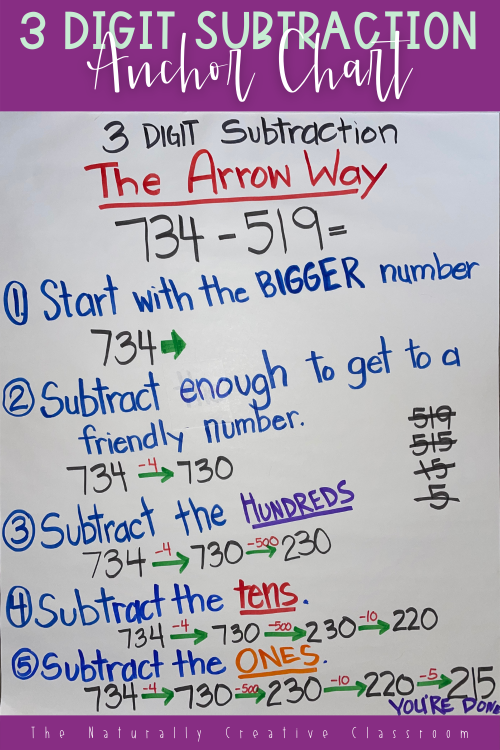
Pros and cons
You start with the biggest number and put a cute little arrow next to it. In the last problem, I immediately took away the hundreds, but here I decided to get to a friendly number first. As you can see on the poster, I kept track of what I had used on the side. For me, the next friendly number is the next ten, which is 730, so I took out 4 ones from 519 and subtracted them from 734.
Once I was at a friendly number, I then took away the 5 hundreds and the 1 ten. I had to remember that I hadn’t used ALL the ones, so I took away the remaining 5 ones. A great way to make sure you have used the entire number is to add up the numbers sitting on the arrow. Does 4+500+10+5=519? Yes, I know I have used the entire number.
If you want to focus on the SIZE of each place value, you can have the children draw longer or shorter arrows depending on the number.
This method does not lean on traditional regrouping, and is much easier to do mentally. Students are also encouraged to think flexibly and are given a choice in how they want to complete the problem.
3 Digit Subtraction Regrouping strategy #5: The Open Number line Way
Last, but certainly NOT least is the Open Number Line Way! I think this is my favorite subtraction strategy. What I like about it is the little “trick” that the biggest number becomes the ENDING point and you actually work backwards. Here is another way that you can do a 3 digit subtraction WITH regrouping WITHOUT actually having to regroup. Take a look:
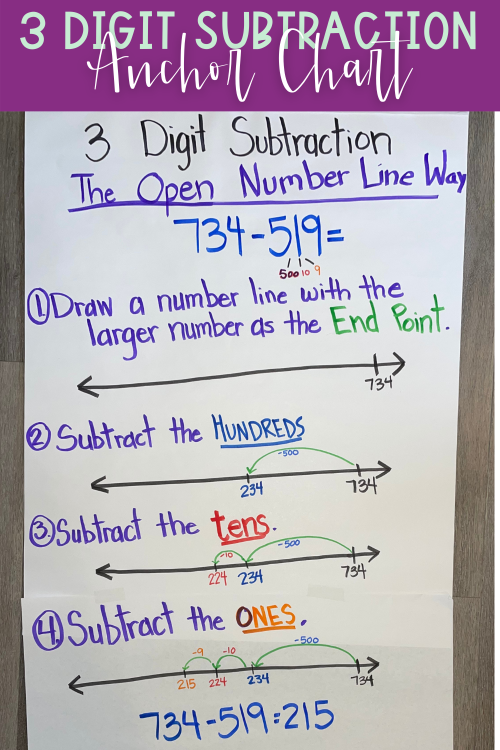
Pros and cons
This 3 digit subtraction with regrouping strategy reminds you that you actually are going DOWN the number line. You put the biggest number on the far right of the number line, and break down the smaller number into its place values.
For the first step, I chose to once again subtract the 5 hundreds (you can also get to a friendly ten number first). Notice how the line for the hundreds is much longer than the lines with the tens and ones? Drawing it this way helps you to quickly spot which students are solid in their understanding of number values, and who needs a little more instruction!
Next I took away the 1 ten, and then the 9 ones. I was able to do this without having to keep track, or write anything else on the sides to help me. This is a great method that students can use to start to transition to mental math or when you are in the checkout watching the numbers go up on the scanner and you need to quickly figure out how much you will have left in your checking account!
This method again emphasizes flexible thinking and a jump into mental math territory. Students will also show the relative size of each of the numbers and have to actively think about place value as they subtract. It does take a little longer than some of the others, but some of your students might enjoy the drawing aspect of this method!
How I can Help!
As a busy teacher, I know that I have been guilty of skipping one or two of these strategies for the sake of time once the class shows that they are proficient in adding. The standard algorithm is the goal, right? It is a fourth grade standard. My own third grade twins had not seen (or remembered seeing) 4 of these strategies before I showed them. As I said before, the last two ways were life changing for the way that I began to think of subtraction.
To make these strategies easy to teach to your students, or to a few students who need a little more differentiation for their developing math brains, I have recorded a series of 3 digit subtraction regrouping videos and videos for addition as well. You can watch them with your students, give to them individually, or use in small groups. I filmed what I wanted for my own students- a teacher doing them pen to paper and clearly explaining each step. You can get one addition video for FREE as a thank you for signing up for my newsletter (hint: it’s in the sidebar)!
Included with these videos is a set of 3 digit subtraction with regrouping anchor charts that go along with the videos. Students can tuck these in their math folders for future reference. One fun idea is to print 4 to a page and slide them onto a ring.


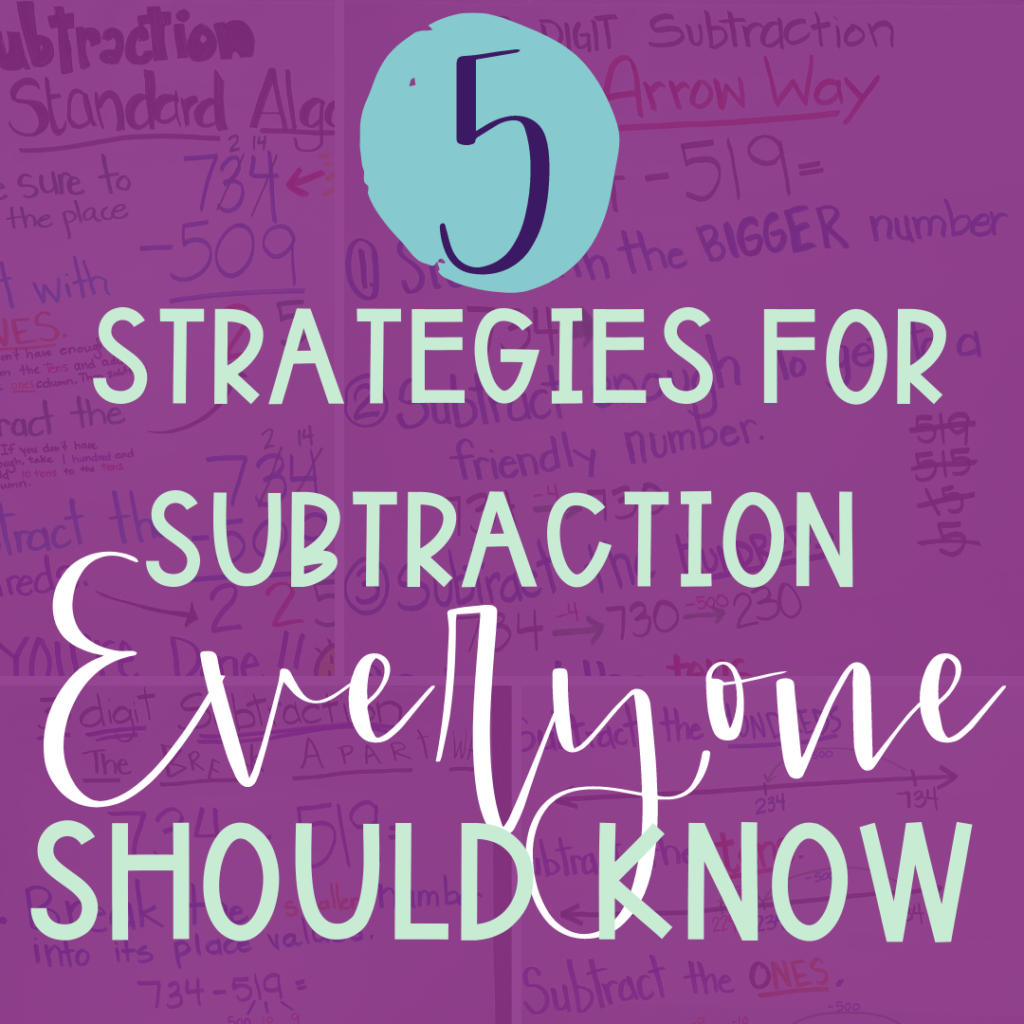

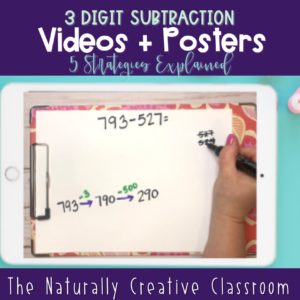
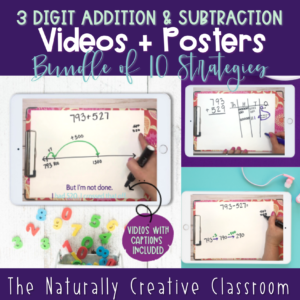
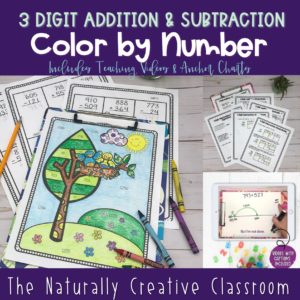

One Response